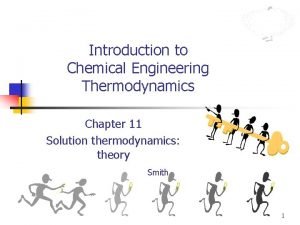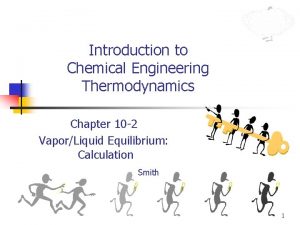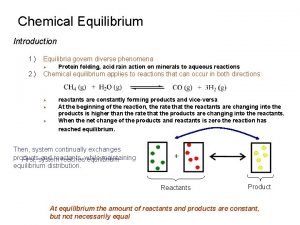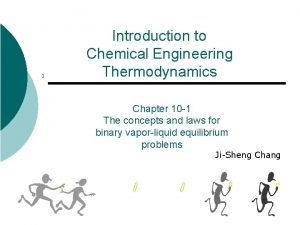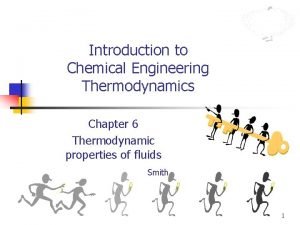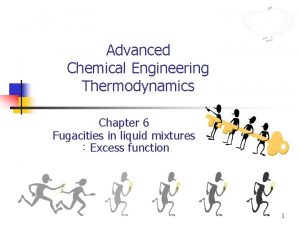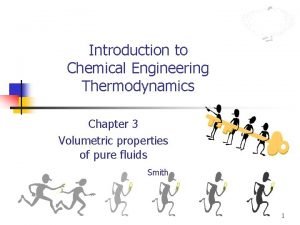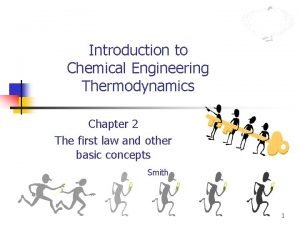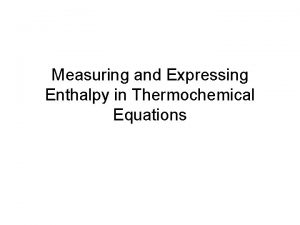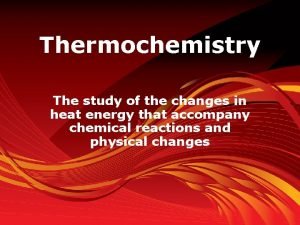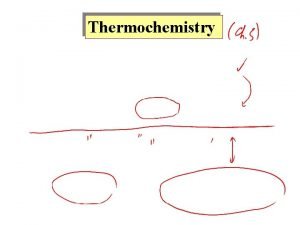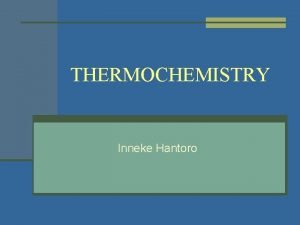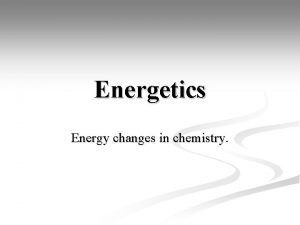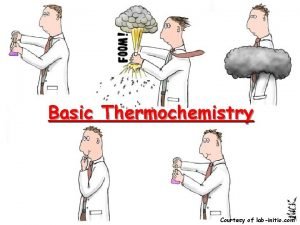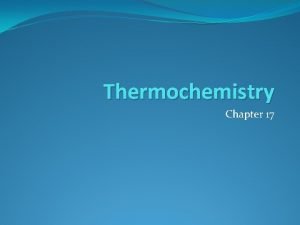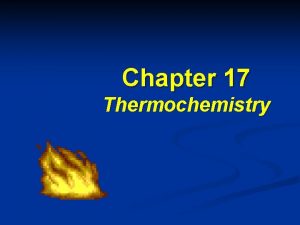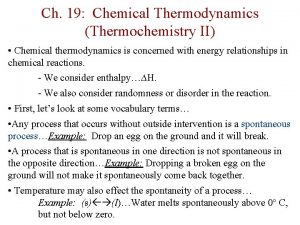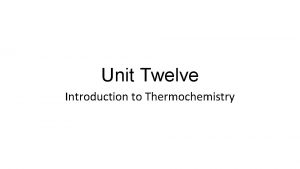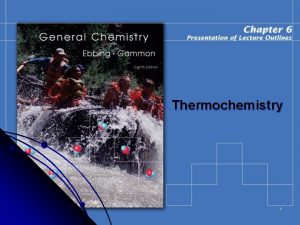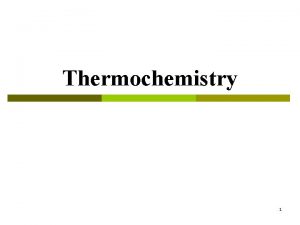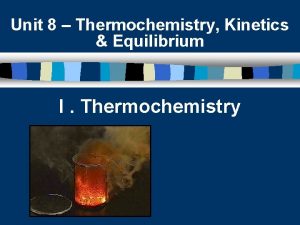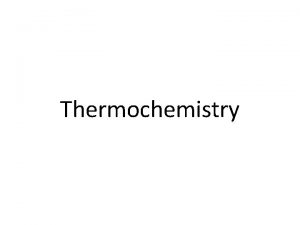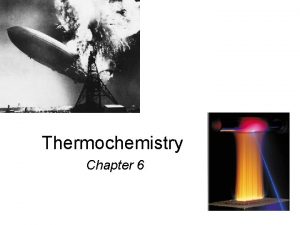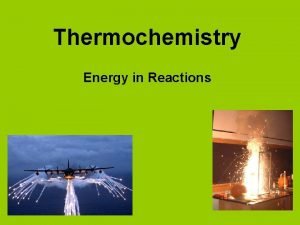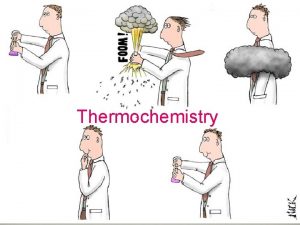Ch 19 Chemical Thermodynamics Thermochemistry II Chemical thermodynamics
















- Slides: 16

Ch. 19: Chemical Thermodynamics (Thermochemistry II) • Chemical thermodynamics is concerned with energy relationships in chemical reactions. - We know enthalpy…∆H. - We also know randomness or disorder in the reaction. • First, some vocabulary terms… • Any process that occurs without outside intervention is a spontaneous process…Example: Drop an egg on the ground and it will break. • A process that is spontaneous in one direction is not spontaneous in the opposite direction…Example: broken egg on the ground will not spontaneously come back together. • Temperature may also effect the spontaneity of a process… Example: (s) (l)…Water melts spontaneously above 0º C, but not below zero.

Reversible and Irreversible Processes • A reversible process - one that can go back and forth between states along the same path. The reverse process restores the system to its original state. • The path taken back to the original state is exactly the reverse of the forward process. • There is no net change in the system or the surroundings when this cycle is completed…Example: At 0º C, water freezing and melting is reversible, but it is irreversible at other temperatures. • Quick Facts: - Chemical systems in equilibrium are reversible. - Completely reversible processes are too slow to be attained in practice. - In any spontaneous process, the path between reactants and products is irreversible.

An Example of Irreversible Processes • In order for the system to go back to the way it was, the surroundings would have to do work on the system which changes the surroundings forever. • This process is therefore irreversible.

Entropy • Nature tends toward disorganization, a more random arrangement of molecules. • This is because disordered arrangements are much more probable than ordered arrangements. • Entropy (S): a measure of the disorder of a system. - The higher the entropy, the greater the degree of disorder. - Processes in which the disorder or entropy of the system increases tend to be spontaneous. - Spontaneous reactions proceed to lower energy, −∆H, or higher entropy, +∆S. • Entropy is a state function…(the path doesn’t matter, only the initial and final states of the system make any difference. ) ∆S = Sfinal – Sinitial If ∆ S > 0 the randomness increases, if ∆ S < 0 the order increases.

Entropy Examples: Entropy 1) Consider the melting of ice… - When it melts, the molecules have more freedom to move increasing degrees of freedom. - The molecules are more randomly distributed and have more entropy. 2) Consider a KCl crystal dissolving in water… - The solid KCl has ions in a highly ordered arrangement. When the crystal dissolves the ions have more freedom. They are more randomly distributed…more entropy. - However, now the water molecules are more ordered. Some must be used to hydrate the ions. Thus this example involves both ordering and disordering. (The disordering usually predominates for most salts. ) In general: A gas is less ordered than a liquid which is less ordered than a solid. Any process that increases the # of gas molecules leads to an increase in entropy. Also, the more complex the molecule is, the more entropy it has.

Entropy of Dissolving

Entropy Things to note… • Boiling corresponds to a much greater change in entropy than melting. • Entropy will increase when… - liquids or solutions are formed from solids. - gases are formed from solids or liquids. - the number of gas molecules increase. -the temp. is increased.

Relating Entropy to Heat Transfer and Temperature • Suppose a system changes reversibly between state 1 and state 2… Example: A phase change occurs at constant T with the reversible addition of heat such as freezing/melting equilibrium for water at 0º C. • Then, the change in entropy at constant temperature is given by: ∆Ssys = q(rev)/T (…where q(rev) is the amount of heat added reversibly to the system. ) • The subscript “rev” reminds us that the path between states is reversible.

Entropy & the 2 nd Law of Thermodynamics • 2 nd Law of Thermodynamics: In any spontaneous process, the entropy of the universe increases. • The change in entropy of the universe is the sum of the change in entropy of the system and the change in entropy of the surroundings. ∆Suniv = ∆ Ssys + ∆ Ssurr • For a reversible process: ∆ Suniv = ∆ Ssys + ∆ Ssurr = 0 • For a spontaneous process (i. e. , irreversible): ∆ Suniv = ∆ Ssys + ∆ Ssurr > 0 Therefore, entropy is not conserved… ∆ Suniv is continually increasing. • Note: The second law states that the entropy of the universe must increase in a spontaneous process. It is possible for the entropy of a system to decrease as long as the entropy of the surroundings increases.

Entropy & the 3 rd Law of Thermodynamics • In a perfect crystal at 0 K there is no translation, rotation or vibration of molecules. Therefore, this is a state of perfect order. • Third Law of Thermodynamics: the entropy of a perfect crystal at 0 K is zero.

Entropy Changes in Chemical Reactions • Absolute entropy can be determined from complicated measurements. • Standard molar entropy, S : entropy of a substance in its standard state…(This is similar in concept to H. ) • Units: J/mol-K… (Note: units of H are in k. J/mol. ) • Standard molar entropies of elements are not zero! • For a chemical reaction: S = ΣS products − ΣS reactants Example: Consider the reaction: N 2(g) + 3 H 2(g) 2 NH 3(g) S = 2 S (NH 3) – [S (N 2) + 3 S (H 2)] • The values for standard entropies are in Appendix C in the textbook. • We could just look them up and plug and chug!. . . (See Practice Problems)

Gibbs Free Energy: Predicting Spontaneity • We know that spontaneous reactions increase entropy of the universe, and that exothermic reactions also tend to be spontaneous. • But what’s the deal with spontaneous endothermic reactions? Or how about a spontaneous exothermic reaction that decreases entropy? • Both concepts, enthalpy and entropy, drive the spontaneity of chemical reactions. • How do we balance S and H to predict whether a reaction is going to be spontaneous? • Gibbs Free Energy: G = H – TS • For a process occurring at constant temperature… G = H–T S - If G is (–), the reaction is spontaneous in the forward direction. - If G is (+), the reaction is spontaneous in the reverse direction. - If G = 0 the reaction is at equilibrium.

Standard Free Energy Changes • We can tabulate standard free energies of formation, Gof. • Standard states are: pure solid, pure liquid, 1 atm (gas), 1 M for solutions, and Gºf = 0 for elements. • We most often use 25º C (or 298 K) as the temperature. • The standard free-energy change for a process is given by: Gº = Σ Gºf (products) - Σ Gºf (reactants) Standard Free Energy and Temperature • Often times, temperature will determine if a reaction is spontaneous. G = H + (– T S) enthalpy term entropy term NOTE: G does not give us information on the speed of a reaction!

Standard Free Energy and Temperature • If H < 0 and S > 0, then G is always negative…(spontaneous. ) • If H > 0 and S < 0, then G is always positive…(nonspontaneous) • If H < 0 and S < 0, then G is negative at low temperatures. • If H > 0 and S > 0, then G is negative at high temperatures. NOTE: Even though a reaction has a negative G it may occur too slowly to be observed.

Free Energy and the Equilibrium Constant • It is useful to determine whether substances under any conditions will react. • Here’s a formula which will determine if a reaction will occur: G = Gº + RT ln. Q …where Q is the reaction quotient which is similar to Keq but it is not at standard conditions. • “R” is the ideal gas constant, 8. 314 J/mole·K, and “T” is the temperature in Kelvin. • Again, (–) G means the reaction will be spontaneous in the forward direction. • When a reaction is at standard conditions, Q = 1, so… ln Q = 0. • See Practice Problems for all of the examples!

Free Energy and the Equilibrium Constant • At equilibrium, Q = Keq and G = 0, so… Gº = − RT ln. Keq • From the above we can conclude the following: - If G < 0, then K > 1…the reaction will go forward. - If G = 0, then K = 1…the reaction is at equilibrium. - If G > 0, then K < 1…the reaction will go in reverse. • Here’s the equation rearranged to solve for Keq: Keq = o/RT – G e • Be sure ∆Gº is in units of k. J/mol, and the values in the equilibrium expression are in atm or moles/L. • Finally, if you want a nonspontaneous reaction to proceed, you have to supply energy to the system to “drive” it forward. Nature does this often. (See p. 765 for more details. )
 Chemical engineering thermodynamics 8th solution chapter 4
Chemical engineering thermodynamics 8th solution chapter 4 Chemical engineering thermodynamics 8th solution chapter 10
Chemical engineering thermodynamics 8th solution chapter 10 Equilibrium thermodynamics
Equilibrium thermodynamics Duhem theorem
Duhem theorem Chapter 6
Chapter 6 Chapter 6
Chapter 6 Chemical engineering thermodynamics 8th solution chapter 3
Chemical engineering thermodynamics 8th solution chapter 3 Introduction to chemical engineering thermodynamics
Introduction to chemical engineering thermodynamics Thermochemical equation
Thermochemical equation Q = m x cp x delta t
Q = m x cp x delta t Intro to thermochemistry
Intro to thermochemistry Kinetic energy thermochemistry
Kinetic energy thermochemistry Introduction to thermochemistry
Introduction to thermochemistry What is thermochemistry
What is thermochemistry Thermochemistry cartoon
Thermochemistry cartoon Thermochemistry is the study of
Thermochemistry is the study of Chapter 17 thermochemistry
Chapter 17 thermochemistry
